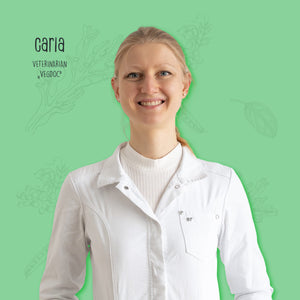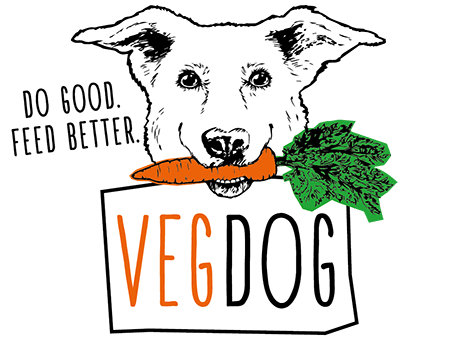
food allergy in dogs
We are increasingly finding the so-called common diseases that we originally know from humans in dogs. It is not unusual today for us to be told at the dog park that another owner's dog has an allergy. In addition to an environmental allergy (for example to certain pollen and grasses), this is usually a reaction to the dog food. Today we would like to clear up the numerous myths surrounding food allergies in dogs.
 Author: Carla Steffen
Author: Carla Steffen
 Proofreader: Veronika Hajek
Proofreader: Veronika Hajek
Updated: 01.10.2024
Published: 25.04.2024
The most important information at a glance
- A food allergy is a defensive reaction of the immune system.
- Dogs are often allergic to animal proteins, grains containing gluten or soy. Food mites can also cause a reaction.
- Such an allergy can be recognized by skin reactions and gastrointestinal problems.
- Elimination diets are useful for diagnosis. Blood tests, however, are not recommended as they are very inaccurate.
- The food allergy can be treated well by changing the food.
What is a food allergy?
In the case of a food allergy, the immune system fights against components of the food consumed with a defensive reaction. These are usually protein molecules that are recognized as foreign to the body. These molecules can have many different origins. They often come from the meat that is consumed (beef, chicken, lamb, etc.). Proteins of plant origin such as wheat or soy can also trigger allergies. In contrast, some four-legged friends react to so-called food mites. These are small arachnids whose presence in dry food cannot always be avoided. Contrary to popular belief, freezing the food is not a suitable method of treating the allergy. The mites are then dead - but still contained in the food. They are therefore still recognized by the dog's body as allergy triggers.
Recognize symptoms: skin and gastrointestinal problems
- sore and itchy paws
- Reddened areas between the paws
- Itchy rash in the neck area
- Inflamed ears
The main symptom is usually annoying itching . This can occur all over the body , but also in individual areas, such as the ears . These can then become very inflamed and painful. Another area that is often affected is the paws .
Here's how you can check for yourself whether your dog is nibbling and licking them: Look at the fur between the toes of each paw. Is it reddish in color? Then that's a strong indication that the dog's saliva has had an effect. A food allergy could be the trigger. Please note that some dogs react to this type of illness with gastrointestinal problems in addition to or exclusively.
Blood tests, exclusion diets & Co. – options for diagnosing a food allergy
There are several ways to diagnose a food allergy. Some of them are very inaccurate, not conclusive (and expensive!), but are still offered in many practices. We recommend that you stay away from any blood tests that are supposed to determine which food component your four-legged friend is allergic to. These tests are very inaccurate!
The gold standard (the method that is the most sensible and accurate of all) is the elimination diet - also known as an exclusion diet. Here, your dog is given a diet consisting exclusively of a single protein and carbohydrate source over a period of 8 weeks. The dog should never have had either before! Horse meat and (sweet) potatoes are often used. Since there are increasingly four-legged friends who cannot tolerate any type of meat, the use of vegetarian or vegan components (for example lupine and lentils) can help.
In addition to the option of preparing the diet yourself, you can buy ready-made food that meets the requirements for an exclusion diet. (Important: While the exclusion diet is being carried out, no treats, table scraps, etc. may be fed!) If the symptoms improve in the following weeks, this is the first indication that it could be an allergic reaction to the food. The last step is to feed the original food that supposedly caused the allergy again. If the symptoms return, your furry friend is most likely suffering from a food allergy.
Suitable dog food: What should I feed if my dog has a food allergy?
You can then reuse the diet used for diagnosis to provide relief for your dog. Please note, however, that the addition of oil and mineral powder is necessary in the long term to prevent deficiency diseases. Be sure to contact a specialist in animal nutrition to have a suitable recipe prepared or use ready-made food that meets your dog's needs, such as vegan VEGDOG dog food . Growing dogs can only be put on an elimination diet for around three weeks without the addition of supplements. Please be sure to contact a specialist before putting your puppy on an elimination diet.
Complete foods for dogs suffering from food allergies are available in stores. The protein molecules that would cause a reaction are so broken down (or so broken down) that the body no longer recognizes them as foreign. Since inferior ingredients, such as feather proteins, are sometimes used, we recommend that you seek advice when making your selection.
A food allergy is no longer the end of the world. With the right approach, it is easy to diagnose and treat. We at VEGDOG are constantly working to make our vegan recipes as compatible as possible so that our four-legged customers with medical problems or restrictions can benefit from our food. If you have any questions, please feel free to contact us at tierarzt@vegdog.
Your VEGDOG team
FAQ
How does a food allergy manifest itself?
A food allergy in dogs can manifest itself through symptoms such as itching, skin rashes, ear infections and gastrointestinal problems.
Which meat are dogs most allergic to?
A study examined the main allergens in dogs. It was found that the following allergens triggered the most reactions in the dogs that tested positive: beef (34%), chicken (15%) and lamb (14.5%). In addition to these types of meat, the four-legged friends also showed positive reactions to dairy products (17%) and wheat (13%).
Which dog food does not cause allergies?
There is no one food that is tolerated by all dogs. After all, allergens can vary from four-legged friend to four-legged friend. However, hypoallergenic food, such as that from VEGDOG, tries to avoid the main dog allergens and thus create a dog food that is tolerated by as many furry friends as possible.








